
Fossils are the preserved remains of ancient life forms, giving us a window into the past. Over the years, numerous remarkable fossil discoveries have reshaped our understanding of prehistoric life and evolutionary history. In this article, we will explore the top 10 best fossil discoveries that have captivated scientists and enthusiasts alike.
Table of Contents
1. Tyrannosaurus Rex “Sue”

The Tyrannosaurus Rex, famously known as “Sue,” holds the title of the largest and most complete T. rex specimen ever found. Discovered in 1990 by paleontologist Sue Hendrickson in South Dakota USA, this remarkable fossil has shed light on the world of dinosaurs. The fossil was dated to approximately 67 million years ago. Its well-preserved skeleton has been a crucial resource for understanding the anatomy, behavior, and ecosystem of this fearsome predator.
Sue is now a permanent feature of the FIELD MUSEUM OF NATIONAL in Chicago, Illinois.
2. Archaeopteryx – The Missing Link

Often referred to as the “missing link” between dinosaurs and birds, Archaeopteryx is a significant discovery in the field of paleontology. Found in the 19th century in Germany, this ancient creature possesses both avian and reptilian characteristics.
Its feathered wings have provided crucial evidence supporting the theory of avian evolution from dinosaurs.
3. Lucy (Australopithecus afarensis) – Ancient Hominid Fossil

Lucy, an Australopithecus afarensis fossil that lived in East Africa approximately 3.2 million years ago, is one of the most celebrated discoveries in human evolutionary history. Discovered in Ethiopia in 1974 by a team of researchers led by paleoanthropologist Donald Johanson, Lucy’s partial skeleton has provided valuable insights into the early stages of human evolution.
This remarkable fossil has led to groundbreaking discoveries about our hominid ancestors and their bipedal locomotion.
4. Ichthyosaur Fossils – Marine Reptiles from the Past

Ichthyosaurs were a group of ancient marine reptiles that roamed the seas during the Mesozoic era (251 million to 65.5 million years ago). Their fossils have been found worldwide, revealing a diverse range of species with well-preserved skeletons.
These fascinating discoveries have enhanced our knowledge of marine ecosystems in prehistoric times.
5. Burgess Shale Fossils – Cambrian Explosion Revelations

The Burgess Shale in Canada has yielded extraordinary fossil finds from the Cambrian period. These fossils represent a diverse array of marine life, providing a unique glimpse into the “Cambrian explosion” when complex life forms rapidly evolved. The detailed preservation of soft tissues has been instrumental in understanding early animal diversity.
6. Coelacanth – Living Fossil Connection

The Coelacanth is a living fossil that has astonished the scientific community. Thought to be extinct for millions of years, the discovery of a living Coelacanth in 1938 in South Africa was groundbreaking. This remarkable find connected us to ancient fish species, and its anatomy provided insights into the evolution of early vertebrates.
7. Tiktaalik – From Water to Land

Tiktaalik is a significant fossil discovery that bridges the gap between fish and land-dwelling animals. Found in Canada, this transitional fossil exhibits both fish-like and tetrapod-like characteristics. Tiktaalik’s discovery offered crucial evidence of the transition from aquatic to terrestrial life during the Devonian period.
8. Pterosaur Fossils – Winged Reptiles of the Past

Pterosaurs were flying reptiles that ruled the skies during the Mesozoic era. These winged creatures were not dinosaurs but belonged to a distinct group. Fossil discoveries of various pterosaur species have revealed fascinating adaptations for flight and provided insight into the diversity of these ancient flyers.
9. Hominin Footprints at Laetoli – Preserved Traces of Early Humans

The Laetoli footprints, discovered in Tanzania, offer a unique perspective on early human behavior. These footprints, dating back over 3.6 million years, are believed to belong to Australopithecus afarensis individuals. Studying these footprints has provided valuable information about early hominid locomotion and social interactions.
10. The “Tully Monster” – Mysterious Fossil Discovery

The “Tully Monster” is an enigmatic fossil with a debated classification. Found in Illinois, USA, this ancient creature’s unique features have puzzled scientists for decades. Its exact identity and evolutionary significance continue to be subjects of ongoing research and discussion.
Conclusion
Fossil discoveries are like time capsules that transport us back to ancient worlds and offer tantalizing glimpses of life’s evolution. The top 10 best fossil discoveries mentioned in this article have revolutionized paleontology and expanded our knowledge of the natural world. They serve as a reminder of the Earth’s rich history and the diverse array of life forms that once inhabited our planet.
FAQ
Can fossils provide clues about ancient climates?
Yes, the study of fossilized flora and fauna can offer valuable information about past climates and ecosystems.
How do scientists preserve and study fossils?
Scientists use various techniques like casting, molding, and digital scanning to preserve and study fossils without damaging them.
What is the oldest fossil discovery in the world?
The oldest known fossil discovery is that of stromatolites, dating back over 3.5 billion years.

2 Comments